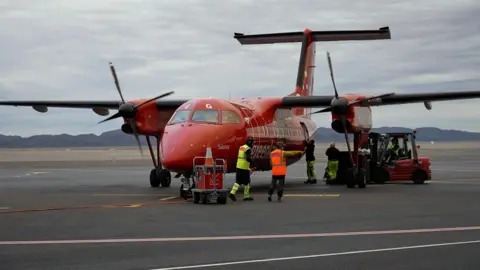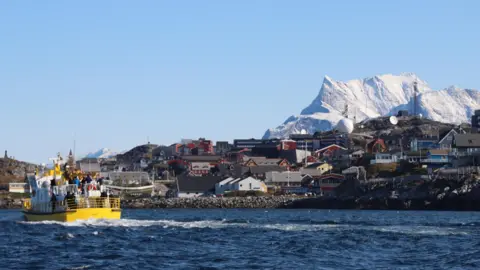Greenland will get a new international airport in the capital Nuuk
 BBC
BBCA new international airport will soon open in Greenland's capital Nuevo, allowing large aircraft to land for the first time – paving the way for direct flights from the US and Europe.
It's the first of three airport projects that officials hope will boost the local economy by making the Arctic region more accessible than ever.
Covered by an ice cap and sparsely populated, Greenland is a large autonomous region within the Kingdom of Denmark.
Its capital Nuuk, on the southwest coast, is a small town of 18,000 inhabitants. Modern apartment blocks and colorful wooden cottages look out over a wide sea fjord.
Perched on a hill above the city, the small 35-seat propeller plane takes off and lands from the tarmac airstrip. Today anyone wishing to fly abroad must first fly one of these planes to a remote former military airport in Kangerlussuaq, 200 miles (319 km) north, and then change to a larger plane.
Built by the Americans in World War II, Kangarlussuaq is currently one of only two runways in Greenland long enough for large jets. The other is Narsarsuaq in the far south of the country, and is also a former US military base.
But from the end of November, thanks to a new long runway and a sleek new terminal building, large planes will be able to land in Nuuk for the first time.

“I think it will have a big impact,” said Jens Lauridsen, chief executive of operator Greenland Airport “I'm sure we'll see a lot of tourism, and we'll see a lot of change.”
When I visited, excavators were moving piles of rubble along the edge of the extended runway and the finishing touches were being applied to the new terminal.
From November 28, direct flights to Nuuk will carry more than 300 passengers from Copenhagen. And next summer, United Airlines will begin flights from New York, as Nuuk becomes Greenland's main travel hub.
“We've been closed off from the whole world, and now we're going to open up to the world,” said a young Nuuk resident. “It's so exciting that we're going to have the opportunity to travel to another country from here.”
In 2026, a second international airport will open 350 miles north of Nuuk, in the town of Ilulissat, Greenland's most popular tourist destination. Ilulissat is famous for the huge icebergs that float just off its coastline. A new regional airport, Kakartok, the largest city in the south of Greenland, will then follow.
Isak Finn, another young Greenlander from Nuuk, said he wouldn't miss Kangarlusua changing plans. “It takes a lot of time. You have to wait, and then if there's bad weather or there aren't enough planes, you're stuck. It's very disturbing.”
National carrier Air Greenland chief executive Jakob Nieter Sørensen said Nuuk's new international airport “is going to be a big game changer for us”. “It's going to shorten travel time and it's going to reduce the cost of producing flights.
Ticket prices are already low, he said, and as demand grows, the airline hopes to add new European and North American routes and potentially invest in new aircraft. But stiff competition is expected as larger international airlines enter the market.
“A flight from Europe to Nuuk takes just over four hours,” says Jens Lauridsen. “It's also a four-hour drive from the US East Coast. So we're placed right in the middle. There is a very, very big interest from all the big carriers in Europe.”
To make way for Nuuk International Airport's long runway, six million cubic meters of rock were blasted and leveled. The airport is now equipped with advanced technology that allows aircraft to land in the city's notoriously bad weather.
Cold conditions and short summer season pose a challenge for construction work. The cost of obtaining explosives ballooned after the war in Ukraine began.
The three airports together cost $800m (£615m). It is partly financed by the Danish, who stepped in with a sweetened loan package after interest from Chinese investors.
“There was concern about whether such investment should be in the hands of the Chinese,” explains Javier Arnatt, head of Arctic social science at the University of Greenland. “Denmark offers more affordable and attractive rates for these loans.”

In the beginning there was public skepticism about the cost and environmental impact, Mr Arnatt said, but now there is mostly support. But not everyone welcomes noisy airplanes.
“With big infrastructure it always divides people,” Nuuk resident Karen Motzfeld told the BBC. “There's always a group that's against it and there's always a group that loves it. So it's the same with Nuuu.
“This is an airport for a modern Greenland,” he added. “I'm looking forward to a short stop to Copenhagen, Iceland or maybe London Heathrow, who knows?”
Greenland's economy is largely dependent on the public sector and fishing, and most products are imported, but there are efforts to diversify. Politicians hope this new infrastructure will be a shot in the arm for sectors such as mining and tourism.
“In all these cases, infrastructure is important. It makes everything easier,” said Naja Nathanielsen, Greenland's Minister of Business, Trade and Mineral Resources, adding that the ease of travel will also help the government boost bilateral ties.
If large cargo planes are able to land in Nuuk sooner, more products can come in and exports can go out more easily.
Large quantities of prawns are being steamed, peeled and frozen inside a harborside factory in the capital. For its owner, the Greenlandic company Polar Seafoods, which sells shrimp, crab and halibut, short and direct flights mean new business opportunities.
“We're looking at more fresh seafood,” said chairperson Michael Binzer.
Currently their products are exported in frozen form via container ships, destined for markets such as China, Scandinavia and the UK. But the company is conducting airfreight trials before opening new airports.
However, it is tourism that will be the big winner. Foreign visitors came to Greenland in record numbers last year, up 36.5% from 2022 to more than 140,000. This is still modest, but is projected to increase with more flight options.
“We're already in the midst of a tourism boom, and experiencing how tourism can affect small places positively, but also negatively,” said Ms. Nathanielsen, who is overseeing a new tourism law that will be introduced this fall.
“We really want to try to welcome tourists to the big cities, but we want to spread them out more.”

In Nuuk, many tourism businesses are eagerly preparing. “Everyone is very excited about how it will turn out,” says Maren-Louise Poulsen Christensen, co-owner and manager of Inuk Hostel.
The business has invested in new glass igloo huts to attract year-round tourists.
Elsewhere, new hotel plans are slowly emerging, but a shortage of accommodation may still put the brakes on efforts to expand tourism. Ms Christensen said the nook needed more rooms, local guides and staff.
Yet he worries that Greenland might “develop tourism too quickly… like what happened in Iceland, so I think we have a lot we can learn from them.”
Business Minister Naja Nathanielsen said the new airports would have a “profound” impact on local communities. “I have a feeling that this is really going to change the map of Greenland.
“It will bring a lot of good, but also some changes we will probably have to adjust.”


